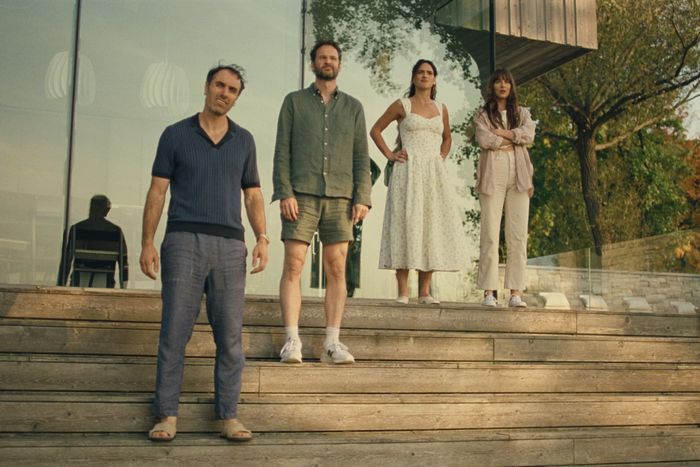
The four corners of a love rhombus.
Photo: NEON
The best way I can come up with to get at the fizzy-drink delights of Splitsville is to describe a scene that takes place maybe a quarter of the way through the movie, after one of the two marriages at its center has imploded. Ashley (Adria Arjona) has recently informed her husband, Carey (co-writer Kyle Marvin), that she wants a divorce so she can sleep with other people. Not long after this bombshell, Carey learns that his best friend Paul (director and co-writer Michael Angelo Covino) and his wife, Julie (Dakota Johnson), have an open marriage. Having just had his world rocked — twice — Carey returns to the apartment that he and Ashley share, determined to preserve the remnants of his relationship by proving that he, too, can handle non-monogamy.
What follows is a montage of Ashley enthusiastically hurling herself back onto the dating scene, taking on a string of lovers — like himbo bartender Jackson (Charlie Gillespie), sensitive chiropractor Fede (David Castañeda), and brusque chef Antoneta (Nahéma Ricci) — that Carey, in a demonstration of the chillness he obviously isn’t actually feeling, befriends so enthusiastically that they all keep hanging around the place after Ashley dumps them. That’s a funny idea in itself, but what sets Splitsville apart is the way the sequence unfolds: in the style of a long take wherein the camera moves around a loft that, incidentally, has no walls. As Ashley heads out on or comes back from her latest date, Carey helps one ex with his resume, consoles another, and joins an increasingly large crew for movie night. The condensed nature of the scene makes the pileup even more absurd, like an escalating series of dares, with Ashley increasingly irritated to find her erotic adventures being countered by Carey’s shows of unbotheredness in a way that threatens to crowd them both out of their own living space.
Cram in the best (and possibly only) joke ever successfully made about the 1992 medical drama Lorenzo’s Oil, and the result is deliriously rewarding. Splitsville is a comedy that’s grounded in its characters, but also has a downright old-fashioned devotion to the visual, to the ways in which the farcical sight of four guys crammed onto a sofa can be just as capable of generating laughs as a good line. Covino and Marvin are longtime friends who run a production company together. After years of working on ads and branded content, they made The Climb in 2019, expanding on a short from the year prior in which they played besties with a toxic dynamic. That first comedy, a critical hit that had the misfortune of coming out during the pandemic, crackled with the energy of two people finally getting to show off what they could do, on-screen and behind the camera, and Splitsville expands on those ambitions while keeping the same rueful appreciation for its main characters’ fallibilities and friendship. Its topic — people dipping a toe into different relationship structures, only to struggle to admit that what they actually want is pretty traditional — may be trendier, but Splitsville is also about how much our commitments to one another can endure and what ultimately causes them to splinter.
They can endure a lot, as Julie reflects when she admits to Carey that what bothers her is not the idea of her husband having sex with other people, but the fact that he seems to be choosing the company of those other people over spending time with her and their son, Russ (Simon Webster), repeatedly leaving them in their gorgeous beach house to return to the city on alleged business. Johnson — who, in the wrong role, can glide smirkingly above the surface of a movie — is perfectly cast here as the most reasonable member of a love rhombus, luminous in high-end mom gear, hiding an amused smile after shocking someone with an unexpected kiss. Arjona acquits herself admirably as well in a more screwball part, but this is Marvin and Covino’s showcase, and they are hyperaware of their own strengths and weaknesses as performers. The fact that they’re essentially a pair of character actors paired with stunning leading ladies informs the dynamic of their characters’ senses of self, their feelings that they’re able to punch above their weight only because they have thrown themselves entirely into being the affable nice guy (Carey) or the obsessive rich one (Paul).
It also doesn’t hurt that they have no preciousness about their own dignity. One of the movie’s best scenes is an epic fistfight between the two men in which a lot of painstaking choreography was enlisted to make something that looks hilariously awkward and wreaks havoc on that high-end home Paul is so proud of. In Splitsville, Covino and Marvin keep adding elements onto each set piece like a juggler being tossed more and more pins to keep in the air, until each sequence teeters on the verge of collapse. That it never ends up there is a testament to how precise a work the film actually is, creating an illusion of chaos that’s only possible with incredible control.
Source link

:max_bytes(150000):strip_icc()/dakota-2b67ff8536df473ca7438fc61f236cf8.jpg)
